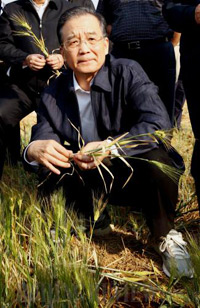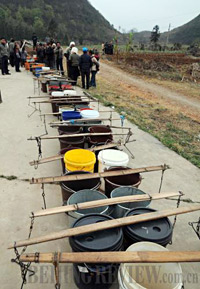|
 |
 |
|
CARING FOR PEOPLE: Premier Wen Jiabao checks the barley affected by drought at Shizikou Village of Luliang County, Yunnan Province, on March 19, during an inspection trip (YAO DAWEI) |
PRECIOUS GIFT: Villagers queue for water in Panxian County in Guizhou Province on March 13. The county has taken different measures to ease the shortages of drinking water for people (LU WENCHUN) |
The worst drought in about a century has turned much of south and southwest China into parched fields and dry rice paddies, with no drinking water for thirsty villagers.
After more than 200 days with hardly a drop of rain, the drought is affecting millions of people in Yunnan, Guizhou, Sichuan provinces, Guangxi Zhuang Autonomous Region and Chongqing Municipality, which represent 83 percent of drought-stricken areas across the country.
Since autumn last year, such drought-hit areas of China have received only half their annual average rainfall and water stores are depleted, China's State Commission of Disaster Relief (SCDR) said on March 19.
The drought had caused direct economic losses of 19 billion yuan ($2.78 billion) as of March 17 and nearly 1 million hectares of farmland has become unproductive.
Water shortage
The dangerous drought has resulted in a shortage of drinking water for millions of people and in livestock and crop failures.
As of March 17, the severe drought has affected 51 million people in south and southwest China, leaving more than 16 million people and 11 million livestock with drinking water shortages, the SCDR said.
About 4.35 million hectares of farmland were affected, the commission said.
Crop production in drought-hit areas will be reduced by 50 percent of last year's yield, said Zhang Yi, Director of the National Farming Technique Promotion Center of the Ministry of Agriculture.
On March 18, the Guizhou Provincial Government issued a drought alert, warning the dry period that started in July last year had seriously affected living conditions and calling for further anti-drought efforts.
The local civil affairs department said 86 of the 88 cities within the province are drought-hit regions, with 5.57 million people and more than 2 million livestock suffering from water shortages.
The disaster has cut irrigation for 830,000 hectares of farmland, including 28,947 hectares that are seriously affected.
Average precipitation in the province was 47.7 millimeters since December last year, half that in the same period in the previous year, the Flood Control and Drought Relief Headquarters of Guizhou said. Water inflow in some major rivers has dropped by 90 percent and water reserves in all reservoirs in the province dropped by about 32 percent.
In the neighboring Yunnan Province, the drought has left more than 7 million people short of drinking water. The drought has also affected more than 2 million hectares of farmland and threatened the water supply of more than 4 million livestock.
The amount of rainfall in Yunnan between September 2009 and March 2010 dropped about 60 percent compared with previous years, said Zhu Yong, Director of Yunnan Provincial Meteorological Center.
He said that the drought in some regions was the most serious in 100 years and would persist until mid-May.
As of March 18, all 77 counties and cities in Guangxi had been affected, and more than 2.2 million people and 1 million livestock are suffering from a lack of water. An area of 523,000 hectares of farmland has been affected.
The Meteorological Bureau of Guangxi said the rainfall in the region has decreased 20 percent, and the situation is not expected to improve in April.
The latest figures released by the Chongqing Municipal Flood Control and Drought Relief Office show the drought has left 940,000 people and 420,000 livestock suffering from a shortage of adequate drinking water and affected 180,000 hectares of farmland across the municipality.
Heavy rainfall for Chongqing is not expected until mid-April.
In Sichuan, the drought has affected more than 510,000 hectares of farmland, leaving more than 1.8 million people and more than 2.2 million livestock short of potable water, statistics from the Provincial Flood Control and Drought Relief Office show.
In efforts to help resolve drinking water crises, the Ministry of Water Resources and State Flood Control and Drought Relief Headquarters held emergency meetings to help drought-stricken provinces carry out water supply plans and water resource management.
| 